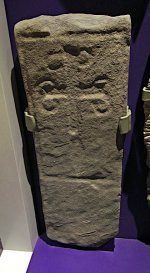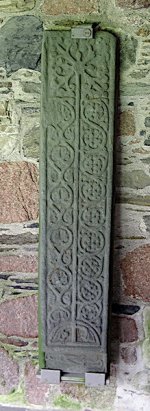One of the oldest and most important religious centres in Britain
Iona is a small island off the coast of Mull and reached by a foot ferry. Visitor vehicles are not allowed on the island. People visit for the isolated beauty, traditional life style, walks, but above all for its early Christian heritage. Iona Abbey is one of the oldest and most important religious centres in Britain. This was where Christianity started and spread to the rest of Britain.

Iona was on a busy sea route connecting Ireland, Scotland, Isle of Man and England. St Columba (Colum Cille) arrived here in 563AD with twelve of his followers, and established the first monastery here. It rapidly became one of the most important monasteries in the British Isles and a seat of learning and art. The beautifully illustrated Book of Kells, now in Dublin Library, was made here around 800AD.
The original monastery was a collection of wooden buildings surrounded by a massive earth bank, the Vallum, which acted as a boundary separating the spiritual and secular worlds. Part of this bank can still be seen to the north west of the abbey buildings.
Near the buildings was a small mound, Torr an Aba, where St Columba had a small shed he could retire to and write. There is a good view of the Abbey and surrounding area from the top.

When St Columba did in 597 at the age of 75, he was buried in a small richly decorated wooden building. Adomnan, born thirty years after St Columba’s death, became the ninth Abbot, wrote the first ‘Life of St Columba’ around 690. This was a mixture of fact and popular tradition which had grown up around the saint.
Around 800AD the original wooden building was replaced by a stone chapel, St Columba’s shrine. His bones were dug up and, along with some of his most treasured belongings, were placed in a richly decorated reliquary chest. By now, the Abbey was a focus for pilgrimage attracting increasing numbers of pilgrims. The pilgrims arrived at Martyr’s Bay which is south of the modern pier and followed a set route visiting areas associated with St Columba’s many miracles before arriving at the shrine along what was called Sraid nam Marbh, or the Street of the Dead.
The abbey suffered a series of Viking raids in the C8th & C9th when gold and jewels were stolen, monks killed and the wooden monastery burnt to the ground. It was replaced by stone in 818AD but was again badly damaged in raids in 825 and 849. The surviving relics were taken to Dunkeld Cathedral and Kells in Ireland for safe keeping. By around 900AD, the Vikings had settled in the area, embraced Christianity and adopting St Columba as their patron saint.
There was one last raid in Iona at Christmas 986AD by Danish Vikings settled in Dublin. They knew the monastery treasures would be on display for the festive Christmas Mass. The Abbot and 15 monks were murdered.
Around 1200, Reginald MacDonald of Islay, one of the sons of Somerled, who had taken control of the area around 1100, invited Benedictine Monks to rebuild Columba’s monastery. They encouraged pilgrims to St Columba’s shrine.
Work began in 1200 on an aisleless cross shaped church, with small transepts.

The monastery was endowed with lands and churches on Mull and the neighbouring islands. As the monastery grew in importance, the chancel was extended in 1250 to house a larger choir and a crypt was built to house relics. Side choir aisles were built to help manage the movement of pilgrims. There was an ambitious remodelling in the mid 1400, when the crypt was removed, possibly as it was in danger of collapse. This explains the two arches and central column that start half way up the north wall. The north side aisle became the Sacristy. The nave was widened to the south, and the west front and crossing tower were built. The carved capitals of the crossing arches still survive.
By 1450, the monastery buildings were complete with the abbey church with cloisters on the north side with the dormitory, refectory and abbot’s house.

After the Reformation in 1560, the monastery fell into disrepair. Over 350 stone crosses around Iona disappeared. In 1630, Charles I tried to use the east end of the abbey church as a Cathedral of the Isles, but the attempt failed and and the abbey was left to become a ruin.
At the end of the C19th, the eighth Duke of Argyll, whose family had owned land on Iona for over 200 years, initiated the rebuilding of the abbey. In 1899 he transferred ownership to the Iona Cathedral Trust who continued the restoration work which was finally completed by the Iona Community in 1965. They now occupy part of the buildings.

The care of the abbey passed to Historic Environment Scotland in 2000.
Iona is a small island off the coast of Mull and reached by a foot ferry. Visitor vehicles are not allowed on the island. People visit for the isolated beauty, traditional life style, walks, but above all for its early Christian heritage. Iona Abbey is one of the oldest and most important religious centres in Britain. This was where Christianity started and spread to the rest of Britain.
Iona was on a busy sea route connecting Ireland, Scotland, Isle of Man and England. St Columba (Colum Cille) arrived here in 563AD with twelve of his followers, and established the first monastery here. It rapidly became one of the most important monasteries in the British Isles and a seat of learning and art. The beautifully illustrated Book of Kells, now in Dublin Library, was made here around 800AD.
The original monastery was a collection of wooden buildings surrounded by a massive earth bank, the Vallum, which acted as a boundary separating the spiritual and secular worlds. Part of this bank can still be seen to the north west of the abbey buildings.
Near the buildings was a small mound, Torr an Aba, where St Columba had a small shed he could retire to and write. There is a good view of the Abbey and surrounding area from the top.
When St Columba did in 597 at the age of 75, he was buried in a small richly decorated wooden building. Adomnan, born thirty years after St Columba’s death, became the ninth Abbot, wrote the first ‘Life of St Columba’ around 690. This was a mixture of fact and popular tradition which had grown up around the saint.
Around 800AD the original wooden building was replaced by a stone chapel, St Columba’s shrine. His bones were dug up and, along with some of his most treasured belongings, were placed in a richly decorated reliquary chest. By now, the Abbey was a focus for pilgrimage attracting increasing numbers of pilgrims. The pilgrims arrived at Martyr’s Bay which is south of the modern pier and followed a set route visiting areas associated with St Columba’s many miracles before arriving at the shrine along what was called Sraid nam Marbh, or the Street of the Dead.
The abbey suffered a series of Viking raids in the C8th & C9th when gold and jewels were stolen, monks killed and the wooden monastery burnt to the ground. It was replaced by stone in 818AD but was again badly damaged in raids in 825 and 849. The surviving relics were taken to Dunkeld Cathedral and Kells in Ireland for safe keeping. By around 900AD, the Vikings had settled in the area, embraced Christianity and adopting St Columba as their patron saint.
There was one last raid in Iona at Christmas 986AD by Danish Vikings settled in Dublin. They knew the monastery treasures would be on display for the festive Christmas Mass. The Abbot and 15 monks were murdered.
Around 1200, Reginald MacDonald of Islay, one of the sons of Somerled, who had taken control of the area around 1100, invited Benedictine Monks to rebuild Columba’s monastery. They encouraged pilgrims to St Columba’s shrine.
Work began in 1200 on an aisleless cross shaped church, with small transepts.
The monastery was endowed with lands and churches on Mull and the neighbouring islands. As the monastery grew in importance, the chancel was extended in 1250 to house a larger choir and a crypt was built to house relics. Side choir aisles were built to help manage the movement of pilgrims. There was an ambitious remodelling in the mid 1400, when the crypt was removed, possibly as it was in danger of collapse. This explains the two arches and central column that start half way up the north wall. The north side aisle became the Sacristy. The nave was widened to the south, and the west front and crossing tower were built. The carved capitals of the crossing arches still survive.
By 1450, the monastery buildings were complete with the abbey church with cloisters on the north side with the dormitory, refectory and abbot’s house.
After the Reformation in 1560, the monastery fell into disrepair. Over 350 stone crosses around Iona disappeared. In 1630, Charles I tried to use the east end of the abbey church as a Cathedral of the Isles, but the attempt failed and and the abbey was left to become a ruin.
At the end of the C19th, the eighth Duke of Argyll, whose family had owned land on Iona for over 200 years, initiated the rebuilding of the abbey. In 1899 he transferred ownership to the Iona Cathedral Trust who continued the restoration work which was finally completed by the Iona Community in 1965. They now occupy part of the buildings.
The care of the abbey passed to Historic Environment Scotland in 2000.


